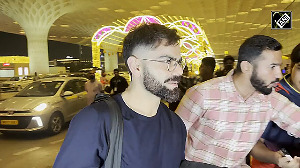The raiding party was drawn from some of the most well-trained elite elements of the Pakistan army. While Ghazi has been killed along with over 40 of his supporters during the prolonged exchange of fire lasting nearly 17 hours, there is an unestimated number of jihadis, who are still putting up a stiff resistance from the basement, where they have taken shelter.
Certain aspects of the operation do not reflect well on President Pervez Musharraf's leadership quality. Once a raid became unavoidable, one would have expected Musharraf to come to the front and explain to the people why the raid has become inevitable. He did not do so. Instead, he asked Shujjat Hussain to explain the reasons for the raid to the people so that if the raid turned out to be messy, the blame would not come onto his shoulders.
When then prime minister Indira Gandhi ordered the Indian Army into the Golden Temple at Amritsar in June 1984, she took the responsibility for the decision, right or wrong, on her shoulders and explained the reasons for her decision to the people of India in a televised address.
Musharraf, on the contrary, has kept an escape route available for him so that if the raid turned out to be messy, he could put the blame onto the civilian political leaders.
The second aspect not reflecting well on Musharraf's leadership quality is that while it is the army's elite units, which have gone into action, the army's GHQ (General Headquarters) has been trying to give the impression that the operation is being co-ordinated by the interior ministry and not the GHQ and that the military units are merely assisting the interior ministry and not playing a leadership role. Again, this is being done to save the army's reputation should the raid turn out to be messy.
This is likely to aggravate the divide between the military and the civilian bureaucracy, which is a defining characteristic of the Musharraf regime ever since he seized power in a coup in October 1999.
Musharraf's advisers have been attributing the slow pace of the operation to the government's anxiety to avoid casualties of innocent people, particularly women, and to the fact that the masjid and the girls' madrassa constitute a huge complex with over 70 rooms.
While the government has given figures of the militants killed by the security forces, it has been silent on the casualties suffered by the girl students of the madrassa. It is very unlikely that in such an intense exchange of fire lasting nearly 17 hours till the time of writing this column, the girl students would have escaped without many casualties.
How serious the backlash against the government in the Pashtun belt will be would depend on the casualties suffered by the girls. Most of them come from the tribal areas and many of them are the daughters of serving and retired soldiers of the Pakistan army. Escalation of violence in the tribal areas and Musharraf's increased physical vulnerability to another terrorist attack would be the inevitable outcome of the operation if a large number of girls get killed. The death of the girls would be more destabilising than Ghazi's death.
There is mounting anger against the Chinese due to the perception that Musharraf decided to act under Chinese pressure. Abusive anti-Chinese slogans were shouted by the tribals during a massive demonstration in the Bajaur Agency area on July 9, in which nearly 20,000 tribals participated. This is a large number for this sparsely-populated area.





